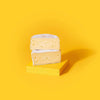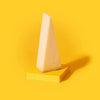How to create the best Christmas cheese board
By Edward Hancock
Sep 15, 2021

How to create the best Christmas cheeseboard
We all have a whole host of traditions when it comes to Christmas, from putting the star on top of the tree to serving up a feast for all the family to. But would Christmas really be Christmas without a Christmas cheese board?
No, we hear you answer. But how often do we end up just plumping for Stilton in a pot, some Brie and a punchy mature cheddar that your Dad and Grandad love but makes your face sting. Not only that, but we also unimaginatively plop the cheese on a wooden board from the 1970s, complemented with grapes and some chutney Granny made years ago that you feel compelled to eat as she watches on like a hawk.
Well, how about this Christmas, we give the cheese a makeover (and not just with the World's Greatest Cheese Advent Calendar). Here is how you can still make sure you are eating the greatest cheese known to mankind, whilst also ensuring some serious WOW factor, putting Christmas cheese, finally, in the spotlight (and Granny's furry chutney backstage).
Here are the basics. Number one, we want the cheese to taste amazing, of course! Secondly, we want the cheese to look amazing as well, so to achieve these we need a good variety and balance of colours, shapes, textures and flavours.
I always try and encourage customers to go for less varieties of cheese, and larger pieces. I would say 5 is the absolute max which allows for a balanced variety. Any more than that and the cheese will lose its presence on the board, plus the pieces will be too small to go around! Another tip over the Christmas period would also be to keep your cheese whole or in big pieces as long as possible. The smaller you cut it, the faster it will deteriorate/dry out.
How much cheese do I need?
This is one of the most common questions I get asked, and the simple answer is, for a responsible eater, 60-80g pp. I see many people recommending 100g plus, but remember, it is Christmas, and you will probably be in a constant state of overindulged stupor. What's more, the Christmas cheese is likely to come at the end of each meal so you’ll likely be re-positioning yourself on your chair trying to open up pockets of space in your stuffed belly!
Ingredients for a Christmas cheese board
120g Red Onion & Port Marmalade
120g Wild Cloudberry Jam
1 x Peter's Yard Original Sourdough Crispbreads
Thinly sliced apples and pears
2-3 Halved/Quartered Figs
Handfuls of Walnuts and Cornichons
The perfect cheeses for a festive feast
When it comes to Christmas cheese, I am a firm believer in pushing some boundaries without trying to reinvent the wheel. Seasonality is also a huge consideration, people tend to be really aware of seasonal fruit and vegetables, but not so aware of how seasonal cheese is. This explains why I don't eat goat's milk cheese at Christmas. Whilst staggered breeding means it is now available, there is no doubt that goat's milk cheese in Spring is the best of the best, so I wait until then.
First up we have Sparkenhoe Red Leicester. A truly historic cheese, this is the only raw milk, farmhouse Red Leicester made in the world. It is nothing like the supermarket versions, and I hope that as more people try this cheese the quicker the misconceptions about Red Leicester being bland and boring will be dispelled. It is really important you encourage guests to eat this cheese first, as the flavours are complex but mild. You will get some earthiness, a hint of butter, and a lovely nuttiness. Have this cheese at the end, and you won't pick up on its nuances.
There is no avoiding the need for a quality cheddar at Christmas and this year I have loved Westcombe Cheddar. Aged for around 1 year, it is one of a small batch of PDO protected West Country Farmhouse Cheddars. This is a badge of authenticity, telling you it is made to traditional methods. I find it so buttery and smooth, whilst still concealing a farmy cheddar punch that you so need and expect from a proper cheddar. Paired with our Red Onion & Port Marmalade, this is Christmas on a plate.
Over to France and their equivalent of Cheddar. Comte is a feat of cheese evolution, having adapted to being made high at altitude, and then stored over the summer in the many little Alpages until the farmers and cheesemakers come down for the winter. The key with Comte is to buy only Summer Comte, as the milk will have been produced by cows eating the lovely meadow grass and drinking fresh sweet water at over 1km above sea level. Have a look at the colour of the Comte, if it is yellow, you know it is summer milk...an ivory or white colour and that is winter milk. If you go for a more matured Comte, you will also get the benefit of lovely crunchy crystals that add an amazing texture to the cheese. As with all great Comte, you should get deep buttery nuttiness, with a slight floral sweetness.
Baron Bigod is my go to soft cheese, and the UK's only raw milk farmhouse Brie. It is made using the milk of Montbeliarde cows, native to France and Switzerland, and famed for their milk which is perfect for cheesemaking. A whole round of the Baron Bigod mini will look brilliant on any cheeseboard, and it will wait patiently for you to cut into it before oozing. It has everything you would want from a Brie style cheese—damp soil, autumn leaves, earthy mushrooms—and an incredibly indulgent silk creaminess. Pair this with our Wild Cloudberry Jam and you might just pass out. Every now and then I come across a pairing that makes me chuckle out loud and look like a madman. This is one of them!
And finally our favourite Stilton, Organic Cropwell Bishop. So earlier I mentioned seasonality of cheese...why is Stilton so inextricably linked with Christmas? Well, Stilton is aged around 12 weeks (or 3 months) and historically, the most lush, delicious grass is the second growth grass that shoots up in September-time when the rains start returning. The cows eat this grass, which passes into their milk, and 3 months maturation later in December, you have the most wonderful Stilton of the year. Just in time for Christmas. Sometimes you have to just accept things in life, and Stilton and Christmas are one of those things. With only 6 makers of blue Stilton in the world, it didn't take us long to find our favourite. Organic Cropwell Bishop has an artisan, complex, multidimensional flavour that you simply don't get with most Stiltons (large scale production = one dimensional taste). I always get a lovely toasted peanut vibe, never too much salt, and the most wonderful smooth finish – none of the harsh bitter metallic taste that characterises so many Stiltons. Paired with our Red Onion & Port Marmalade, it is dreamy.
Pungent pairings for your Christmas cheese platter
All the little extras not only fill your cheeseboard and make it look 'abundant', they also play a part in the enjoyment of the cheese. Thin slices of apple are perfect for eating in between each cheese, as the acidity helps to cut through the cheese and clear the palate, preparing you for the next slice. Walnuts add some lovely texture and crunch, and their slight bitterness is the perfect foil for the creaminess of the cheese. Figs carry an amazing honey sweetness that balance beautifully with the Stilton. And finally, I love cornichons with the Baron Bigod.
I would also say, be brave enough to just eat cheese on its own sometimes. The Sparkenhoe will definitely benefit from being eaten 'naked'. No crispbreads, no condiments, just you and Sparky.
Winter warmers to complement the cheese
If you are conscious of mixing drinks and want to stick with one, I would go with a lightly Oaked Chardonnay. It will work across the board as the slight oaking gives a creaminess that matches that of the cheese (thanks to Malolactic fermentation in the barrels). It also avoids any of the tannins in red wine fighting with the acidity in the cheese.
However, if you wanted to be more adventurous, I would look to pair the Westcombe with a New World Cabernet Sauvignon. I have tried some incredible pairings with Argentinian wines. For the Comte and Baron Bigod, I would go down the white wine route, perhaps a Muscadet sur lie for the Comte and a good quality oaked Chardonnay for the Baron Bigod.
Then finally, for the Stilton, sure you could go with a tawny port, or a big bold Bordeaux that will be able to hold their own against the salty punch of the Stilton. But how about opting for a cheeky Sauternes, or a Pedro Ximenez Sherry, which will over a Yin of sweetness to the Stilton's Yang, rather than taking it on head on.


